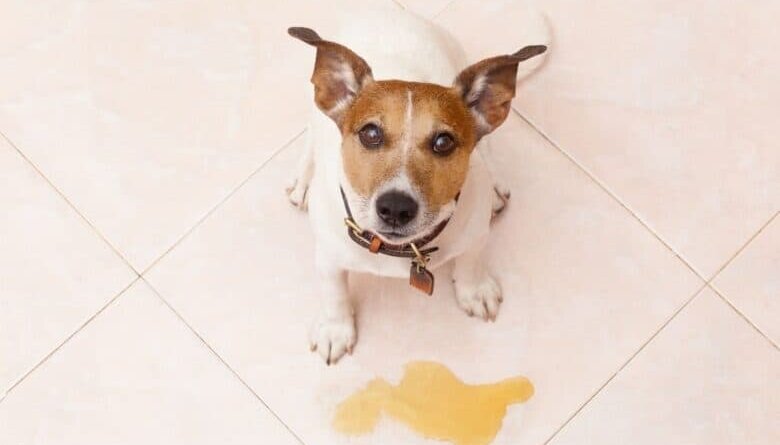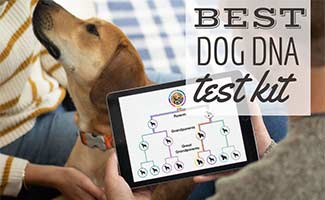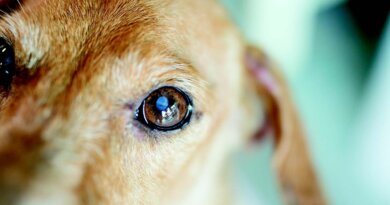Why Does My Dog Pee Next To The Pad And Not On The Pad?
This post may contain affiliate links. We may earn money or products from the companies mentioned in this post.
Your new puppy is so much fun!
Duffy bounces around, happily shaking his squeaky toy. But he also has accidents. A lot of them.
So you decide to use potty pads to help house train him. But he still has accidents near them.
Today’s question: Why Does My Dog Pee Next To The Pad And Not On The Pad?

It’s really frustrating when a dog has accidents in the house.
The information in this article will help you figure out why and what to do about it.
Should You Use a Potty Pad?
It’s important to decide whether you should use a potty pad to help house train your new puppy or dog.
Potty pads can be purchased in pet stores and on-line. Most have a plastic-type backing so that urine can’t touch your flooring.
The top cloth-like top is sometimes scented to draw your dog to use it as his bathroom.
Consider whether you plan on eventually training your dog to go to the bathroom outside.
If so, you may want to go right to that step. Some dogs take longer to learn to potty outside if potty pads are used.
It all depends on your availability, location, and the size your pup will be when full-grown.
Up until they’re about 14 weeks old, puppies have very little bladder control.
If you will sometimes be gone for longer than your dog can “hold it” without having accidents, potty pads can be a useful addition to your house training regimen. This is true of people who work long hours.
But note that a dog needs companionship, exercise, and training too and shouldn’t be left alone too long.
If you live in a high-rise and can’t get your puppy outside quickly enough for him to go to the bathroom, potty pads can help when training him.
If your puppy will be a small or toy-sized breed when an adult, you may want to train him to go to the bathroom on a pad.
Or even if you adopt an adult dog that’s small, you may decide to use a potty pad.
You may also choose to use potty pads when your dog’s recovering from an illness or for an older dog who needs to go to the bathroom frequently.
Why Does My Pup Potty Off the Pad?
If you’re reading this, you’re probably trying to train your puppy to go to the bathroom on a potty pad. But you may see him having accidents nearby the pad.
It’s really frustrating. So let’s explore the reasons this may be happening.
- The puppy thinks it’s a toy. Some puppies may potty near the pad, then play with and even shred it. Wow! It’s a fun toy in the pup’s mind.
- The puppy doesn’t understand what the pad’s for. Until a dog’s trained to use the pad, he may potty near–but not on–it.
- The puppy may have a bad aim. Even if he’s been trained regarding the purpose of the pad, he (or she) may not have the best aim in hitting the pad when urinating or defecating.
- The pad’s in a distracting area. If you place the pad in a high-traffic area of your home, your pup may be too distracted to do his business there.
- The pad isn’t always in the same place. It’s important that the pad’s always in the same place. If it’s moved, it may confuse your dog.
- The pad’s not clean. Dogs generally instinctively want to be clean. So, if the pad’s dirty and needs to be changed, some dogs may not want to go to the bathroom there.
- The pad may be too close to where the dog eats or drinks. Generally, dogs don’t want to go to the bathroom near where they eat.
- The dog may not be able to make it to the pad. Sometimes a dog knows what he’s supposed to do but is unable to get to the pad in time to urinate or defecate.
This can be true of young puppies, older dogs, or dogs with a medical issue.
- The puppy isn’t fully house trained yet. Sometimes the answer is that the puppy just isn’t totally house trained.
- The dog may be “getting lazy.” Even a house trained dog may start losing interest in making it to the potty pad.
- There may be a behavioral issue. Some dogs who are stressed or anxious may go to the bathroom in the house.
Or a dog may be marking his territory. (Both female and male dogs may mark.)
- There may be medical problems. There are many possible issues, such as a urinary tract infection. Some of the signs are traces of blood in the urine, straining when urinating, and excessive licking of his private area.
Diabetes is also a disease where a dog may drink and urinate excessively.
Other possible medical problems that can make a dog urinate excessively are Cushings’ disease or kidney failure.
How To Stop a Dog From Pottying Off the Pad
Once you figure out why your dog’s missing the mark on the potty pad, you can fix the problem.
The following are some things to take into consideration when determining what you need to do.
- Housetrain your puppy to use the pad. Sometimes a puppy doesn’t understand what the pad is for. So it helps to take him to the pad and place him on it.
You can use a phrase such as “go potty.” Praise and reward him when he uses the pad as his bathroom.
If he’s used to being on a leash, you can take him to the pad the same way you’d take him outside to house train him,
Try to have him placed on the middle of the pad so he “hits the mark.”
Dogs generally have to go to the bathroom after they sleep, eat, or play. So you should take him to the pad at those times.
To help prevent accidents, I even take a young puppy to the pad even after he’s played for a short time.
Of course, you should praise and reward him when he goes to the bathroom on the pad.
- Make sure the pad is properly located. A dog should have ready access to his pad.
Generally, you want a pad in only one place. But if you have a multi-level house, you may want to have a pad on each level.
It’s important to keep the pad in the same location. Moving it will really confuse a dog regarding what’s expected.
Also, even though a pad should be readily accessible to the pup, it’s important that it isn’t placed where there are too many distractions.
So it probably shouldn’t be placed in a hallway or between two rooms where there’s a lot of foot traffic.
Also, a pad shouldn’t be placed near where a dog eats or drinks. Most dogs don’t want to go to the bathroom near where they eat.
- Maintain a routine. In any type of house training, keeping a schedule is important.
So try to keep regular time the puppy eats, drinks, sleeps, exercises, plays, and trains. You can then better anticipate when he’ll have to potty.
- Don’t give the puppy too much freedom too fast. Puppies and adult dogs that are new to you need supervision.
If not observed, they can have accidents and also be destructive.
- Praise and reward when he goes to the bathroom on the pad. When he’s doing the right thing, praise and reward with a small tidbit.
- Use a litter box or pad holder. Sometimes having a defined area using these devices helps a pup know exactly where to potty on the pad.
A low-sided litter pan in which you place the potty pad helps define where to potty. It also it makes it almost impossible to have accidents off the pad once the pup understands he has to go into the pan to potty.
A pad holder also provides a defined area as well as prevents the pad from moving.
- Change the pee pad to be sure it’s clean. If there’s any feces on the bad, remove it. If the pad is soiled either with feces residue or urine, change the pad and put a fresh one in its place.
Most dogs don’t want to potty in their own waste.
- Use a larger pee pad area. Depending on the size of your pup, the pad may just be too small for him to potty on. The pads come in different sizes.
So you may have to use larger ones or more than one together.
- Use an exercise pen. If you need to confine a puppy for longer than he can “hold it,” you may want to use an exercise pen.
It’s just an enclosure so that the puppy is still safe when you leave him.
By using an exercise pen, you can place a potty pad in one area of the pen, which is his bathroom area.
And you can have a play area with toys as well as a bed for naps.
You can even leave a crate with the door open that he can enter and exit.
The point is that the pup has a defined potty area.
- Scent your dog’s potty pad. Dogs are naturally drawn to their scent. Of course, the pad should be clean, but putting a little piece of a prior pad with your dog’s urine scent may help him go to the bathroom there.
Many pads you purchase already have a scent that should attract him to use it.
- Clean up accidents. If any accidents happen off the pad, promptly clean them up.
- Have your dog checked out by a veterinarian. If you’ve consistently correctly worked on having your pup potty on the pad and he doesn’t, it may be time for a vet visit.
This is true too if you observe any physical problems with your dog such as urinating too often, straining to urinate, or blood in the urine.
- Obedience train your dog. A foundation in basic obedience helps you communicate with your dog and furthers your bond, which helps in all your interactions.
- Get help if your dog has a behavioral issue. If your dog has anxiety issues or is excessively stressed by his environment, or if he marks territory, you may need the assistance of an experienced, positive reinforcement trainer or behaviorist.
Don’t Try This at Home: What NOT To Do
There are some things that you shouldn’t do in trying to correct your pup from pottying off the pad.
- Never scold the puppy for not using the pad or not using it correctly. He may be in the learning phase and the correction may cause confusion and fear.
Or he may be partly on the pad and may think that you don’t want him on it.
Instead, re-train him to properly use the potty pad just as you would a dog for house training outside.
Take him to the pad as you would take him to his outside potty area. Use a potty phrase (“go potty”) and praise and reward with a small treat immediately after he goes to the bathroom on the pad.
Final Thoughts
Using a potty pad is a personal preference depending on your situation.
You still need to train the dog regarding what the potty pad is there for. And make sure that it’s properly placed and kept clean.
Have you used potty pads when training your dog?
If so, were you successful or did your dog pee next to, but not on the pad?
Tell us about your experiences in the comment section below.
Save To Pinterest

Top Picks For Our Puppies
- BEST PUPPY TOY
We Like: Snuggle Puppy w/ Heart Beat & Heat Pack – Perfect for new puppies. We get all of our Service Dog pups a Snuggle Puppy. - BEST DOG CHEW
We Like: Best Bully Sticks – All of our puppies love to bite, nip, and chew. We love using Bully Sticks to help divert these unwanted behaviors. - BEST DOG TREATS
We Like: Wellness Soft Puppy Bites – One of our favorite treats for training our service dog puppies. - BEST FRESH DOG FOOD
We Like: The Farmer’s Dog – A couple months ago we started feeding Raven fresh dog food and she loves it! Get 50% off your first order of The Farmer’s Dog.
Check out more of our favorites on our New Puppy Checklist.




